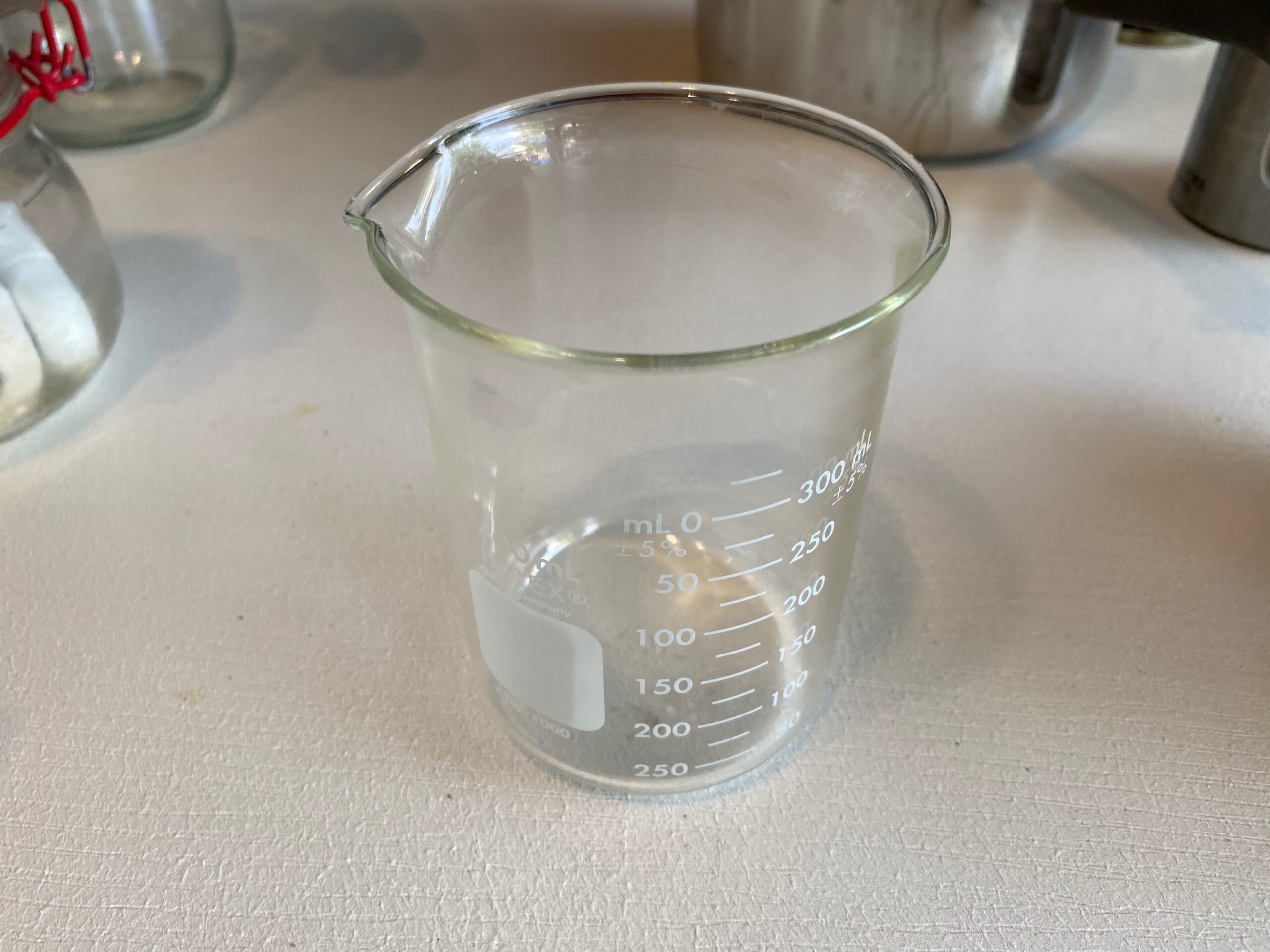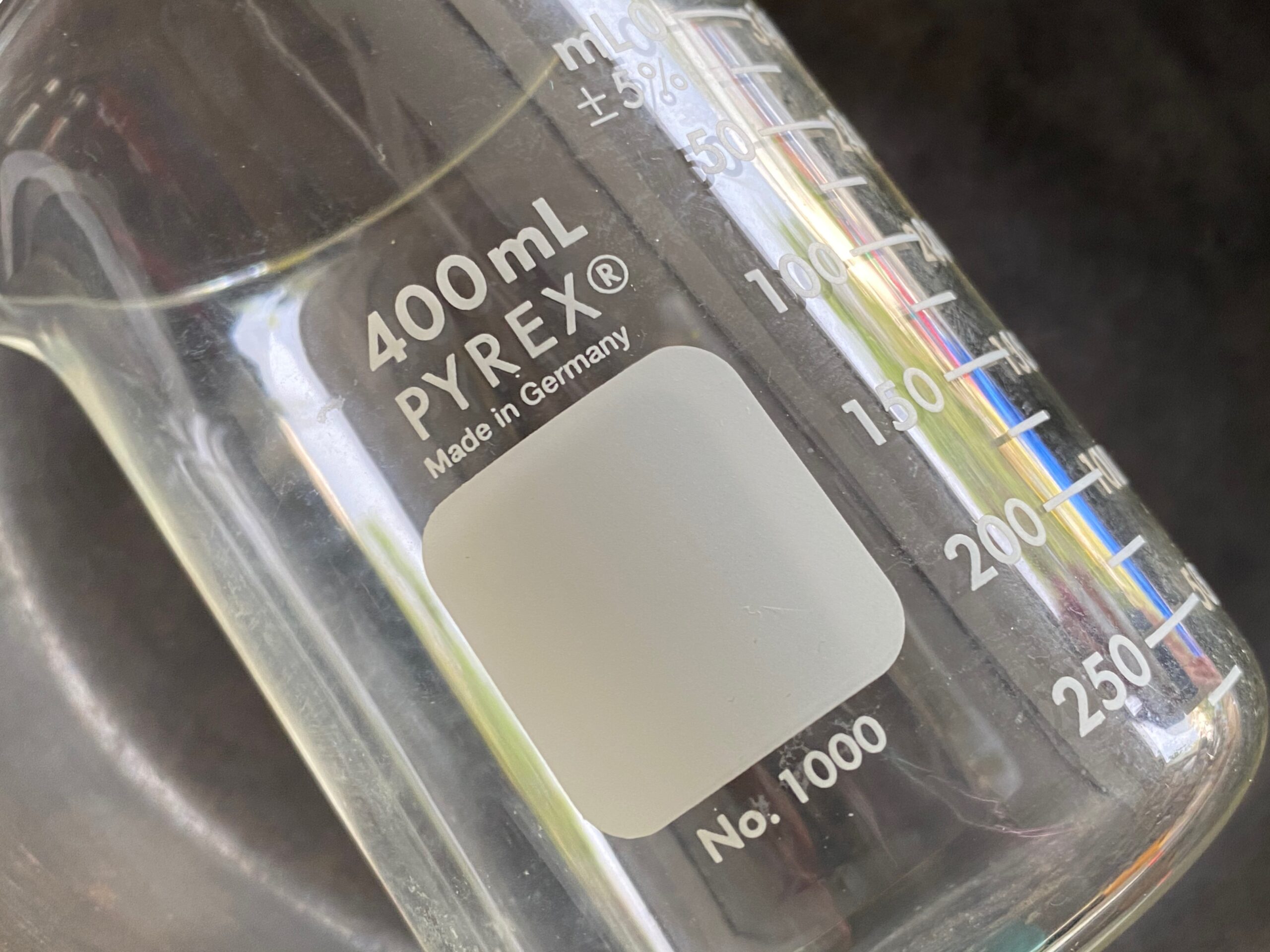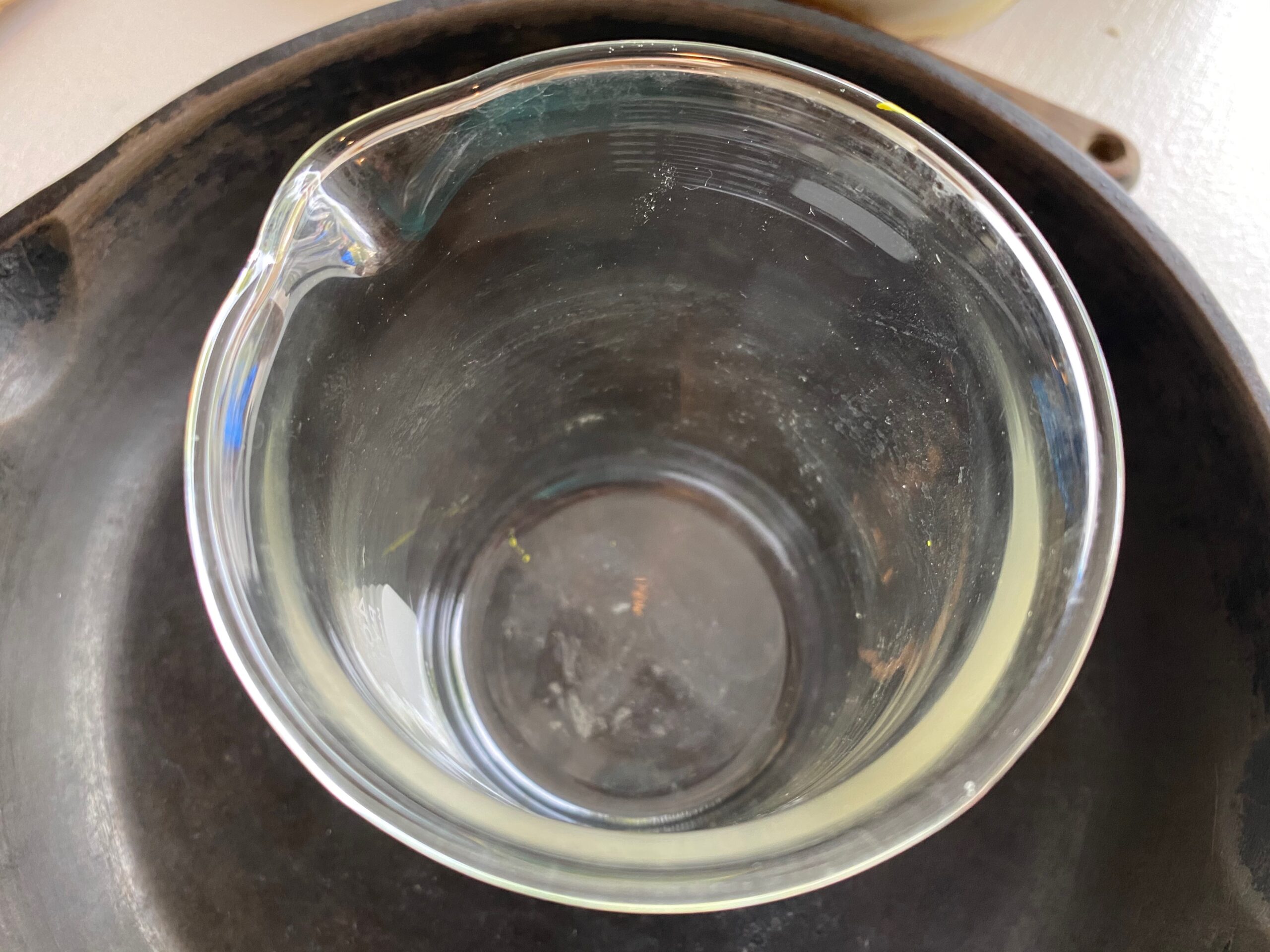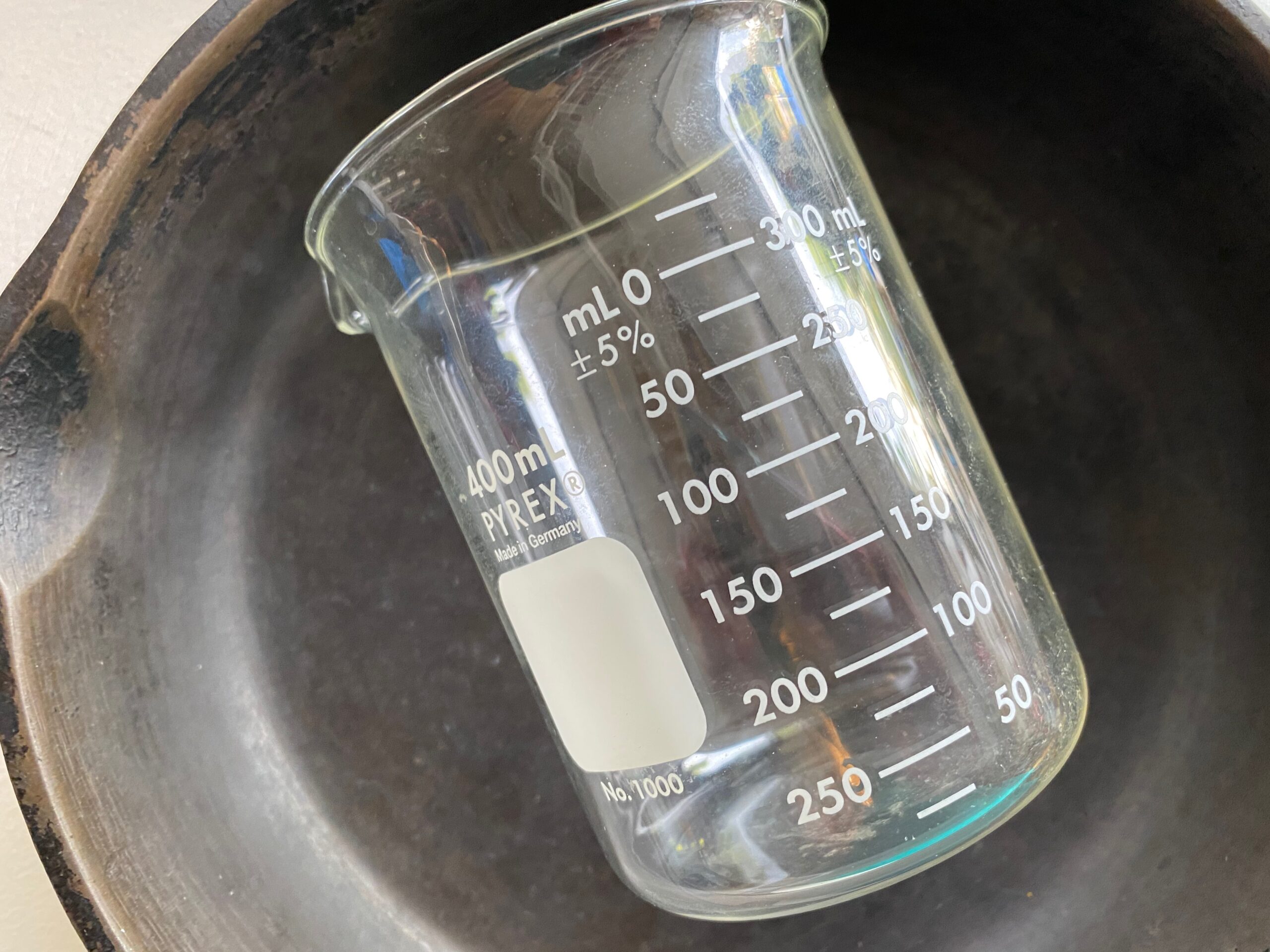400 ml Pyrex (made in Germany) beaker painted with LEAD PAINT! 22,300 ppm Lead. 5000 ppm & up is officially “Lead paint”!
When tested with a high-precision XRF Instrument, the paint on this glass beaker was positive for an unsafe level of Lead.
Today – in the year 2020 (more than two decades in to a new century) – it is still not uncommon for modern glass products (baby bottles, water bottles, measuring cups, mixing bowls, etc.) to be painted with high-Lead-content paint in the decorative markings or measurement markings on the exterior. For some reason, this is an area of manufacturing that has been completely overlooked by our regulatory agencies. In fact, even today – well into the second half of 2020 – it is actually quite common to find modern (newly-manufactured) glass kitchenware products (or other products intended for use with food and beverages) painted with Lead paint in the exterior markings!
Introduction (for those new to this website):
Tamara Rubin is an independent advocate for consumer goods safety. She is also a mother of Lead-poisoned children. She began testing consumer goods for toxicants in 2009 and was the parent-advocate responsible for finding Lead in the popular fidget spinner toys in 2017. Tamara uses XRF testing (a scientific method used by the U.S. Consumer Product Safety Commission) to test consumer goods for the presence of toxicants (toxic heavy metals), including Lead, Cadmium, Mercury, Antimony and Arsenic.
What were the exact XRF test results for the Pyrex (Made in Germany) glass beaker pictured?
- Lead (Pb): 22,300 +/- 700 ppm
- Cadmium (Cd): 171 +/- 15 ppm
- Mercury (Hg): Non-Detect
- Barium (Ba): Non-Detect
- Chromium (Cr): Non-Detect
- Antimony (Sb): Non-Detect
- Selenium (Se): Non-Detect
- Platinum (Pt): 472 +/- 128 ppm
How much Lead is “too much” Lead?
…including some “Fun Facts”:
- Newly-manufactured items (made today) are considered unsafe for children to use if they are finished with any paint or coating that is 90 ppm Lead or higher.
- Substrates that test positive for 100 ppm Lead (or higher) are considered unsafe for children.
- There is currently no regulatory standard setting limits for Lead in paint on modern consumer goods intended for use by adults. [Questions that come up here: Is a beaker intended for use by kids or by adults? Is this the type of beaker children might use in a school science project? If a beaker like this is used in laboratory – how would the presence of Lead paint on the exterior potentially impact any experiments that it is used in? Is this the type of product a person might use in their kitchen for cooking?]
- When Lead-based paint was banned in 1978, the requirement was that paint for residential use (paint for houses, applied in areas that could be reached by children) must henceforth contain less than 600 ppm Lead.
- The allowable level of Lead in house paint was subsequently lowered, and today modern house paint must also be below 90 ppm Lead [and most house paints now usually test completely negative for Lead].
- Federal funds are allocated for interventions in pre-1978 housing (for low income families) when the paint is positive for Lead at a level of one milligram per square centimeter [this is roughly equivalent to a high-precision XRF instrument reading of 5,000 ppm Lead].
So if this Pyrex beaker were made today and considered to be “an item intended for use by children” it might be considered to be illegal (in violation of current regulatory standards set by the U.S. Consumer Product Safety Commission.) If it were ostensibly considered to be “an item intended for use by adults” (which it probably is) it would not be deemed illegal. That said, it is a well-known fact by now – but still bears repeating – that it literally just takes a microscopic amount of Lead to poison a human being!
To reiterate: While there is no regulatory standard limiting Lead content in consumer goods intended for use by adults, ALL U.S. regulatory agencies agree that “there is no safe level of Lead exposure“. Any amount of Lead exposure is considered harmful to humans, and should be avoided. I’m also (separately) concerned about the potential use of Lead painted beakers (and other similar laboratory glassware) in a lab that is ostensibly a sterile and neutral environment!
As adults today (in the modern world), we should work towards eliminating all known and all potential sources of exposure to Lead – because it is the aggregate exposure from all potential sources that is likely to cause long-term harm (it is not necessarily that one particular product might be a specific source of Lead-poisoning for you or for your family — although this has been known to happen with some food-use products [or non-food-use products if ingested]).
In my opinion, any potential exposure is not worth the risk of impacts, especially with an item intended for food-use (or one – like this beaker – that might be used for food-use purposes — regardless of the original intention at the time of manufacture). I often see people using beakers like these as drinking glasses (especially because it is seen as a teaching aid for young children.) In most cases, the Lead paint on a glass cup or beaker like this WILL also even test positive with a reactive agent home test swab (link) — which implies that it is also possible for the Lead in the logo and measurement markings to wear off into your into your home and kitchen environment – you can read more about that concern here.
Here is a link to a similar product (Pyrex Beaker, Made in Germany) sold today on Amazon. In this case I am sharing this link with you so you can see the product is still being sold “in the wild” on Amazon. I am NOT sharing this link with you so that you will purchase it. Please do NOT purchase these:
“What should we do about this?”
The way things work here at LeadSafeMama.com is my readers help direct and follow through on this work. It is a collaborative effort. My readers have me test things using high-precision XRF analysis (you can read more about that here). I report on the test results here on my blog. Then my readers often help with the next steps – and that is what I am asking you to do today. Here are the next steps:
- If you own one of these beakers, you may want to consider no longer using it (especially if you have been using it in your kitchen or as a drinking glass!)
- If you do set it aside, please put it in a sealed plastic bag.
- If you like, for your own curiosity, you could buy some LeadCheck® swabs to test it to confirm it is Leaded, but that is frankly a waste of money at this point (given the level of accuracy, precision, and repeatability of testing using a high-precision XRF instrument)… but I put it out there for those who are so inclined. Here’s a link for LeadCheck® swabs.
- Important note: I don’t know the exact year of manufacture of this piece – the owner told me it was no more than 10 years old … I believe her exact words were that she purchased it new “in the past 5 to 8 years”. In support of this inquiry I would be curious to test newly-purchased examples of these beakers – where the date of purchase and vendor can be confirmed with a receipt.
- Call the manufacturer!!!: Tell them you have been let down. Explain to them that you expected their newly-manufactured products to be healthy and safe. Tell them there is no acceptable amount of Lead in glassware (whether in the painting markings or anywhere else), and ask them to correct the problem. Tell them there are countless companies out there using Lead-free paint in their branding and product measurement markings and they should look to those companies for safer solutions. Ask for a refund, ask for accountability, ask them to reformulate their products to be Lead-free.
- AGAIN: It is NOT illegal for items like this to be painted with Lead paint – it is only irresponsible and unethical. The likely “loophole” that will be cited by Pyrex when this is brought to their attention (if they bother to respond at all) is that these beakers are “made for use by adults”, and therefore there is no regulatory limit on how much Lead the company can use in the paint. HOWEVER, here is one link to a study discussing the potential for harm caused by Lead-painted glassware.
As always, thank you for reading and for sharing my posts. Please let me know if you have any questions, and I will do my best to answer them personally as soon as I have a moment.
Tamara Rubin
#LeadSafeMama
Amazon links are affiliate links. If you purchase something after clicking on one of my links I may receive a small percentage of what you spend – at no extra cost to you.
Never Miss an Important Article Again!
Join our Email List







What manufacturers have lead free measuring cups?
Hi Vivienne,
Tamara has “Measuring Cups & Spoons” recommendations in her shop 🙂 https://shopleadsafemama.com/2021/05/lead-free-measuring-cups-spoons/
This is her new fav: https://tamararubin.com/2022/07/2-cup-glass-measuring-cup-with-pour-spout-and-juicer-lead-free-arsenic-free-cadmium-free-mercury-free-antimony-free-too/
I just received a Kitchenaid 3.5 cup electric food chopper…with the P65 label attached…scared the dickens out of me.
Do I send it back? I do not cook for children and am 70 years old.
How about older pots and pans?
Thank you for your help, your dedication.
Jane